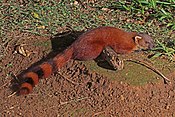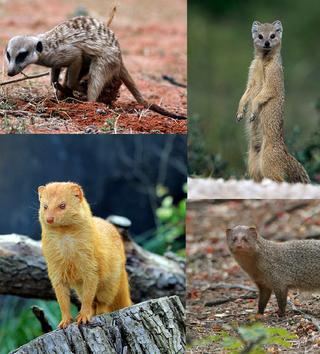
A mongoose is a small terrestrial carnivorous mammal belonging to the family Herpestidae. This family is currently split into two subfamilies, the Herpestinae and the Mungotinae. The Herpestinae comprises 23 living species that are native to southern Europe, Africa and Asia, whereas the Mungotinae comprises 11 species native to Africa. The Herpestidae originated about 21.8 ± 3.6 million years ago in the Early Miocene and genetically diverged into two main genetic lineages between 19.1 and 18.5 ± 3.5 million years ago.

Viverridae is a family of small to medium-sized, feliform mammals. The viverrids comprise 33 species placed in 14 genera. This family was named and first described by John Edward Gray in 1821. Viverrids occur all over Africa, southern Europe, and South and Southeast Asia, across the Wallace Line.
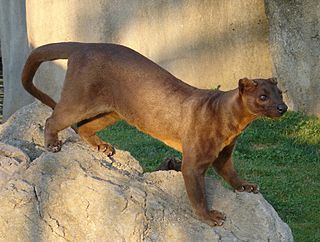
The fossa is a slender, long-tailed, cat-like mammal that is endemic to Madagascar. It is a member of the carnivoran family Eupleridae.

Grandidier's mongoose, also known as the giant-striped mongoose or Grandidier's vontsira, is a small carnivoran that lives only in a very small area of southwestern Madagascar, in areas of spiny forest vegetation. It is pale brown or grayish coloured, with eight wide, dark stripes on its back and sides. Grandidier's mongoose is larger than the related broad-striped Malagasy mongoose, G. fasciata, and its stripes are not as wide. The species is named after Alfred Grandidier.

The Eastern falanouc is a rare mongoose-like mammal in the carnivoran family Eupleridae endemic to Madagascar.
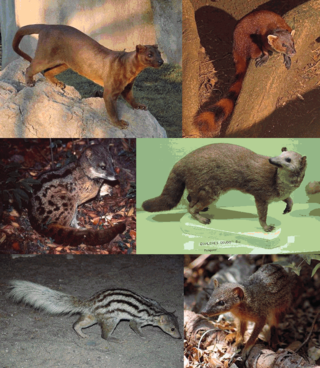
Eupleridae is a family of carnivorans endemic to Madagascar and comprising 10 known living species in seven genera, commonly known as euplerids, Malagasy mongooses or Malagasy carnivorans. The best known species is the fossa, in the subfamily Euplerinae. All species of Euplerinae were formerly classified as viverrids, while all species in the subfamily Galidiinae were classified as herpestids.

The ring-tailed vontsira, locally still known as the ring-tailed mongoose is a euplerid in the subfamily Galidiinae, a carnivoran native to Madagascar. It is the only species in the genus Galidia.

The rusty-spotted genet, also called panther genet and large-spotted genet, is a genet that is widely distributed in sub-Saharan Africa. It is considered common and therefore listed as Least Concern on the IUCN Red List.

The broad-striped Malagasy mongoose or broad-striped vontsira is a species of Galidiinae, a subfamily of mongoose-like euplerids native to Madagascar. The species contains two known subspecies: Galidictis fasciata fasciata and Galidictis fasciata striata.

The narrow-striped mongoose or narrow-striped vontsira is a member of the family Eupleridae endemic to Madagascar. It inhabits the western Madagascar succulent woodlands and northern Madagascar spiny thickets in western and southwestern Madagascar, where it lives from sea level to about 125 m (410 ft) between the Tsiribihina and Mangoky rivers. In Malagasy it is called bokiboky. It is the only species in genus Mungotictis.
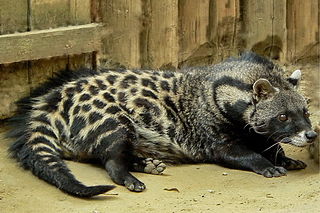
A civet is a small, lean, mostly nocturnal mammal native to tropical Asia and Africa, especially the tropical forests. The term civet applies to over a dozen different species, mostly from the family Viverridae. Most of the species's diversity is found in southeast Asia.

Feliformia is a suborder within the order Carnivora consisting of "cat-like" carnivorans, including cats, hyenas, mongooses, viverrids, and related taxa. Feliformia stands in contrast to the other suborder of Carnivora, Caniformia.
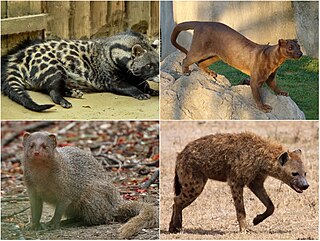
Viverroidea is a clade within feliformia, containing both the family Viverridae, and the superfamily Herpestoidea.

Cryptoprocta spelea, also known as the giant fossa, is an extinct species of carnivore from Madagascar in the family Eupleridae which is most closely related to the mongooses and includes all Malagasy carnivorans. It was first described in 1902, and in 1935 was recognized as a separate species from its closest relative, the living fossa. C. spelea was larger than the fossa, but otherwise similar. The two have not always been accepted as distinct species. When and how C. spelea became extinct is unknown; there is some anecdotal evidence, including reports of very large fossas, that there is more than one surviving species.

The brown-tailed mongoose, brown-tailed vontsira, Malagasy brown-tailed mongoose, or salano is a species of mammal in the family Eupleridae. It is endemic to Madagascar. Its natural habitat is moist lowland tropical forest. It is threatened by habitat loss.

Salanoia is a genus of euplerid carnivoran with two currently described species found in Madagascar. They are mongoose-like, which is reflected in the older versions of their English names, for example brown-tailed mongoose which is now called brown-tailed vontsira. The name Salanoia is derived from salano, one of the vernacular names for Salanoia concolor.
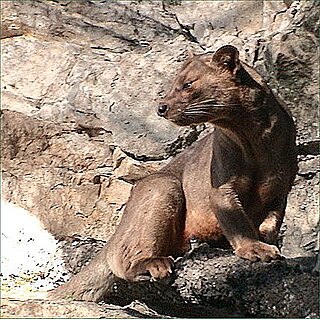
Euplerinae, more commonly known as malagasy civets, is a subfamily of carnivorans that includes four species restricted to Madagascar. Together with the subfamily Galidiinae, which also only occurs on Madagascar, it forms the family Eupleridae. Members of this subfamily, which include the fossa, falanoucs and Malagasy civet, were placed in families like Felidae and Viverridae before genetic data indicated their consanguinity with other Madagascar carnivorans. Within the subfamily, the falanouc and Malagasy civet are more closely related to each other than to the fossa.

Durrell's vontsira is a small, reddish-brown, fox-like mammal native to the island of Madagascar. Discovered in 2004, it lives only in the biodiverse wetlands of Lake Alaotra. Durrell's vontsira belongs to the family Eupleridae, a group of meat-eating, cat- or fox-like mammals found only on Madagascar. The species is closely related to the brown-tailed mongoose, with which it forms the genus Salanoia. The two are genetically similar, but morphologically distinct, and S. durrelli was described as a new species in 2010.

Herpestoidea is a superfamily of mammalia carnivores which includes mongooses, Malagasy carnivorans and the hyenas.


